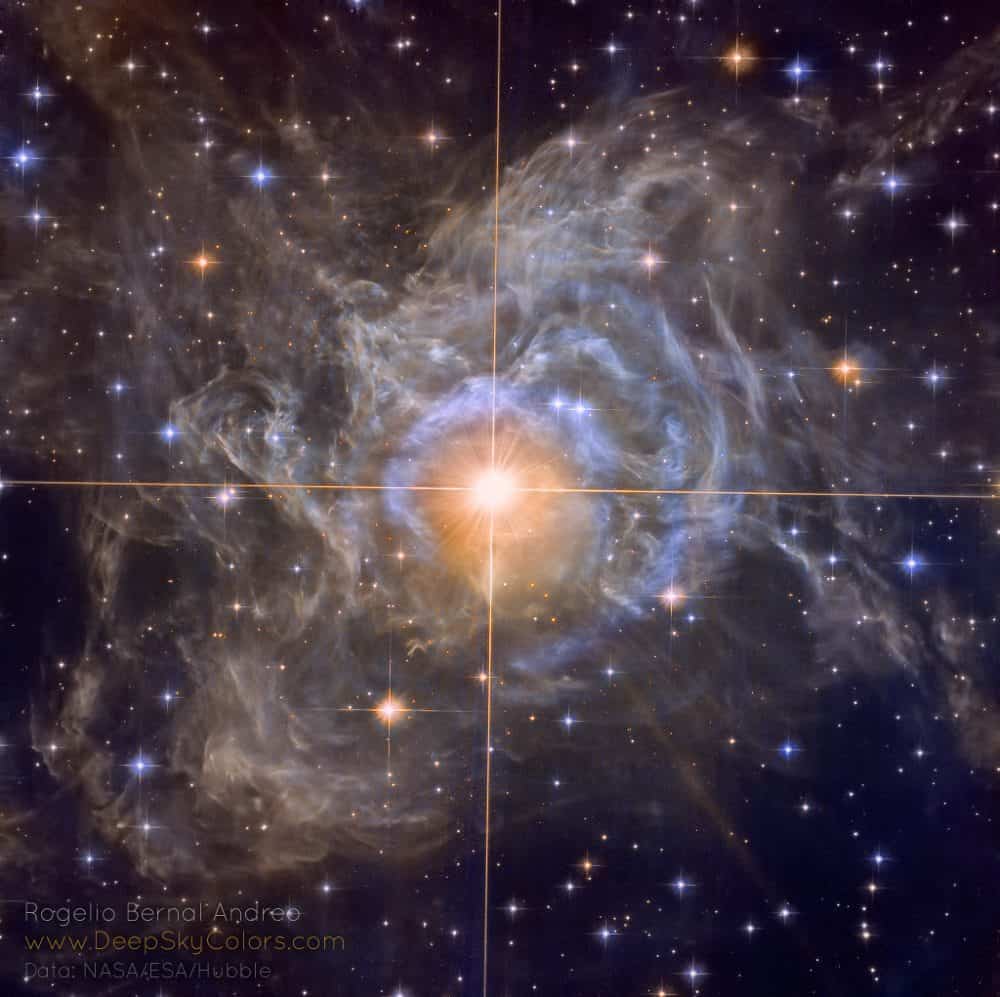Blog
This composite image shows the distribution of dark matter, galaxies, and hot gas in the core of the merging galaxy cluster Abell 520, formed from a violent collision of massive galaxy clusters.
The natural-colour image of the galaxies was taken with the NASA/ESA Hubble Space Telescope and with the Canada-France-Hawaii Telescope in Hawaii. Superimposed on the image are maps showing the concentration of starlight, hot gas, and dark matter. Starlight from galaxies, derived from observations by the Canada-France-Hawaii Telescope, is coloured orange. The green-tinted regions show hot gas, as detected by NASA’s Chandra X-ray Observatory. The gas is evidence that a collision took place. The blue-coloured areas pinpoint the location of most of the mass in the cluster, which is dominated by dark matter. Dark matter is an invisible substance that makes up most of the Universe’s mass. The dark-matter map was derived from the Hubble Wide Field Planetary Camera 2 observations by detecting how light from distant objects is distorted by the cluster of galaxies, an effect called gravitational lensing.
The blend of blue and green in the centre of the image reveals that a clump of dark matter resides near most of the hot gas, where very few galaxies are found. This finding confirms previous observations of a dark-matter core in the cluster. The result could present a challenge to basic theories of dark matter, which predict that galaxies should be anchored to dark matter, even during the shock of a collision.
Abell 520 resides 2.4 billion light-years away.
more...Peter Dennis Blandford Townshend (born 19 May 1945) is an English multi-instrumentalist, singer and songwriter best known as the guitarist, backing and secondary lead vocalist, principal songwriter, co-founder and leader of the rock band the Who. His career with the Who spans over 50 years, during which time the band grew to be one of the most important and influential rock bands of the 20th century.
Pete Townshend is the main songwriter for the Who, having written well over 100 songs for the band’s 11 studio albums, including concept albums and the rock operas Tommy and Quadrophenia, plus popular rock radio staples such as Who’s Next, and dozens more that appeared as non-album singles, bonus tracks on reissues, and tracks on rarities compilations such as Odds & Sods (1974). He has also written more than 100 songs that have appeared on his solo albums, as well as radio jingles and television theme songs. Although known primarily as a guitarist, he also plays keyboards, banjo, accordion, harmonica, ukulele, mandolin, violin, synthesiser, bass guitar, and drums, on his own solo albums, several Who albums and as a guest contributor to an array of other artists’ recordings. He is self-taught on all of the instruments he plays and has never had any formal training.
Townshend has also contributed to and authored many newspaper and magazine articles, book reviews, essays, books, and scripts, and he has collaborated as a lyricist and composer for many other musical acts. Due to his aggressive playing style and innovative songwriting techniques, Townshend’s works with the Who and in other projects have earned him critical acclaim. He was ranked No. 3 in Dave Marsh‘s list of Best Guitarists in The New Book of Rock Lists, No. 10 in Gibson.com’s list of the top 50 guitarists,[5] and No. 10 again in Rolling Stone‘s updated 2011 list of the 100 greatest guitarists of all time. In 1983, Townshend received the Brit Award for Lifetime Achievement; in 1990, he was inducted into the Rock and Roll Hall of Fame as a member of the Who; in 2001, he received a Grammy Lifetime Achievement Award as a member of the Who; and in 2008 he received Kennedy Center Honors. He and Roger Daltrey received The George and Ira Gershwin Award for Lifetime Musical Achievement at UCLA on 21 May 2016.
https://www.youtube.com/watch?v=LQM2NeKdK4o
more...Cecil McBee (born May 19, 1935) is an American jazz bassist, one of the most influential in the history of jazz. McBee has recorded as a leader only a handful of times since the 1970s, but has contributed as a sideman to a number of jazz albums. McBee was born in Tulsa, Oklahoma, on May 19, 1935. He studied clarinet at school, but switched to bass at the age of 17, and began playing in local nightclubs. After gaining a music degree from Ohio Central State University, he spent two years in the army, during which time he conducted the band at Fort Knox. In 1959 he played with Dinah Washington, and in 1962 he moved to Detroit, where he worked with Paul Winter‘s folk-rock ensemble in 1963–64. His jazz career began to take off in the mid-1960s, after he moved to New York, when he began playing and recording with a number of significant musicians including Miles Davis, Andrew Hill, Sam Rivers, Jackie McLean (1964), Wayne Shorter (1965–66), Charles Lloyd (1966), Yusef Lateef(1967–69), Keith Jarrett, Freddie Hubbard and Woody Shaw (1986), and Alice Coltrane (1969–72).
Cornelius “Sonny” Fortune (May 19, 1939 – October 25, 2018) was an American jazz saxophonist. Fortune played soprano, alto, tenor, and baritone saxophones, clarinet, and flute.
After moving to New York City in 1967, Fortune recorded and appeared live with drummer Elvin Jones‘s group. In 1968 he was a member of Mongo Santamaría‘s band. He performed with singer Leon Thomas, and with pianist McCoy Tyner (1971–73). In 1974 Fortune replaced Dave Liebman in Miles Davis‘s ensemble, remaining until spring 1975, when he was succeeded by Sam Morrison. Fortune can be heard on the albums Big Fun, Get Up With It, Agharta, and Pangaea, the last two recorded live in Japan. Fortune joined Nat Adderley after his brief tenure with Davis, then formed his own group in June 1975, recording two albums for the Horizon Records. During the 1990s, he recorded several albums for Blue Note. He has also performed with Roy Brooks, Buddy Rich, George Benson, Rabih Abou Khalil, Roy Ayers, Oliver Nelson, Gary Bartz, Rashied Ali, and Pharoah Sanders, as well as appearing on the live album The Atlantic Family Live at Montreux (1977).
https://www.youtube.com/watch?v=FzCTmdsISRE
more...The irregular galaxy NGC 4485 shows all the signs of having been involved in a hit-and-run accident with a bypassing galaxy. Rather than destroying the galaxy, the chance encounter is spawning a new generation of stars, and presumably planets.
The right side of the galaxy is ablaze with star formation, shown in the plethora of young blue stars and star-incubating pinkish nebulas. The left side, however, looks intact. It contains hints of the galaxy’s previous spiral structure, which, at one time, was undergoing normal galactic evolution.
The larger culprit galaxy, NGC 4490, is off the bottom of the frame. The two galaxies sideswiped each other millions of years ago and are now 24,000 light-years apart. The gravitational tug-of-war between them created rippling patches of higher-density gas and dust within both galaxies. This activity triggered a flurry of star formation.
This galaxy is a nearby example of the kind of cosmic bumper-car activity that was more common billions of years ago when the universe was smaller and galaxies were closer together.
NGC 4485 lies 25 million light-years away in the northern constellation Canes Venatici (the Hunting Dogs).
more...Lou Bennett (May 18, 1926, Philadelphia – February 10, 1997, Paris) was an American jazz organist.
Bennett first played bebop on piano, but started playing organ in 1956 after hearing Jimmy Smith. Bennett toured the U.S. with an organ trio between 1957 and 1959, and then moved to Paris in 1960. There he recorded and performed at the Blue Note with Jimmy Gourley and Kenny Clarke (as well as Rene Thomas); he returned to America only once, for the 1964 Newport Jazz Festival. He also recorded in the 1960s with Philip Catherine, Shirley Bunnie Foy and Franco Manzecchi. In the 1980s he played in his own quintet with Gerard Badini, among others. During this period he also toured extensively throughout Spain, including, Almeria, Barcelona, La Coruna, Segovia, and Madrid.
more...Kai Chresten Winding (/ˈkaɪ
After the war, Winding was a member of Benny Goodman‘s orchestra, then Stan Kenton‘s. He participated in Birth of the Cool sessions in 1949, appearing on four of the twelve tracks, while J. J. Johnson appeared on the other eight, having participated on the other two sessions.
more...
Pulsating RS Puppis, the brightest star in the image center, is some ten times more massive than our Sun and on average 15,000 times more luminous. In fact, RS Pup is a Cepheid variable star, a class of stars whose brightness is used to estimate distances to nearby galaxies as one of the first steps in establishing the cosmic distance scale. As RS Pup pulsates over a period of about 40 days, its regular changes in brightness are also seen along its surrounding nebula delayed in time, effectively a light echo. Using measurements of the time delay and angular size of the nebula, the known speed of light allows astronomers to geometrically determine the distance to RS Pup to be 6,500 light-years, with a remarkably small error of plus or minus 90 light-years. An impressive achievement for stellar astronomy, the echo-measured distance also more accurately establishes the true brightness of RS Pup, and by extension other Cepheid stars, improving the knowledge of distances to galaxies beyond the Milky Way.
more...William Scott Bruford (born 17 May 1949) is an English retired drummer, percussionist, songwriter, producer, and record label owner who first gained prominence as the original drummer of the rock band Yes, from 1968 to 1972 and again from 1990 to 1992. After his departure from Yes, Bruford spent the rest of the 1970s playing in King Crimson, touring with Genesis and U.K., and eventually forming his own group, Bruford.
In the 1980s, Bruford returned to King Crimson for three years, collaborated with several artists including The Roches, Patrick Moraz, and David Torn, and formed his jazz band Earthworks in 1986. He then played in Anderson Bruford Wakeman Howe, which eventually led to his second stint in Yes. Bruford played in King Crimson for his third and final tenure between 1994 and 1997, after which he continued with Earthworks and further collaborations.
On 1 January 2009, Bruford retired from public performance, barring one private gig in 2011. He released his autobiography, and continues to speak and write about music. He operates his record labels, Summerfold and Winterfold Records. In 2016, after four-and-a-half years of study, Bruford earned a PhD in Music at the University of Surrey. He was inducted into the Rock and Roll Hall of Fame as a member of Yes in 2017
https://www.youtube.com/watch?v=93y9wfB3EM8
more...Henry Saint Clair Fredericks (born May 17, 1942), who uses the stage name Taj Mahal, is an American blues musician, a singer-songwriter and film composer who plays the guitar, piano, banjo, harmonica, and many other instruments. He often incorporates elements of world music into his works and has done much to reshape the definition and scope of blues music over the course of his more than 50-year career by fusing it with nontraditional forms, including sounds from the Caribbean, Africa, and the South Pacific.
Born Henry Saint Clair Fredericks, Jr. on May 17, 1942, in Harlem, New York, Mahal grew up in Springfield, Massachusetts. He was raised in a musical environment; his mother was a member of a local gospel choir and his father was an Afro-Caribbean jazz arranger and piano player. His family owned a shortwave radio which received music broadcasts from around the world, exposing him at an early age to world music.
In 1964 he moved to Santa Monica, California, and formed Rising Sons with fellow blues rock musician Ry Cooder and Jessie Lee Kincaid, landing a record deal with Columbia Records soon after. The group was one of the first interracial bands of the period, which likely made them commercially unviable. An album was never released (though a single was) and the band soon broke up, though Legacy Records did release The Rising Sons Featuring Taj Mahal and Ry Cooder in 1992 with material from that period. During this time Mahal was working with others, musicians like Howlin’ Wolf, Buddy Guy, Lightnin’ Hopkins, and Muddy Waters. Mahal stayed with Columbia after the Rising Sons to begin his solo career, releasing the self-titled Taj Mahal in 1968, The Natch’l Blues in 1969, and Giant Step/De Old Folks at Home with Kiowa session musician Jesse Ed Davis from Oklahoma, who played guitar and piano (also in 1969).During this time he and Cooder worked with the Rolling Stones, with whom he has performed at various times throughout his career. In 1968, he performed in the film The Rolling Stones Rock and Roll Circus. He recorded a total of twelve albums for Columbia from the late 1960s into the 1970s. His work of the 1970s was especially important, in that his releases began incorporating West Indian and Caribbean music, jazz and reggae into the mix. In 1972, he acted in and wrote the film score for the movie Sounder, which starred Cicely Tyson. He reprised his role and returned as composer in the sequel, Part 2, Sounder.
In 1976 Mahal left Columbia and signed with Warner Bros. Records, recording three albums for them. One of these was another film score for 1977’s Brothers; the album shares the same name. After his time with Warner Bros., he struggled to find another record contract, this being the era of heavy metal and disco music.
John Lenwood “Jackie” McLean (May 17, 1931 – March 31, 2006) was an American jazz alto saxophonist, composer, bandleader, and educator, and is one of the few musicians to be elected to the DownBeat Hall of Fame in the year of their death.
McLean was born in New York City. His father, John Sr., played guitar in Tiny Bradshaw‘s orchestra. After his father’s death in 1939, Jackie’s musical education was continued by his godfather, his record-store-owning stepfather, and several noted teachers. He also received informal tutoring from neighbors Thelonious Monk, Bud Powell, and Charlie Parker. During high school he played in a band with Kenny Drew, Sonny Rollins, and Andy Kirk Jr. (the tenor saxophonist son of Andy Kirk).
Along with Rollins, he played on Miles Davis‘ Dig album, when he was 20 years old. As a young man McLean also recorded with Gene Ammons, Charles Mingus (for Pithecanthropus Erectus), George Wallington, and as a member of Art Blakey‘s Jazz Messengers. McLean joined Blakey after reportedly being punched by Mingus. Fearing for his life, McLean pulled out a knife and contemplated using it against Mingus in self-defense. He later stated that he was grateful that he had not stabbed the bassist.
His early recordings as leader were in the hard bop school. He later became an exponent of modal jazz without abandoning his foundation in hard bop. Throughout his career he was known for a distinctive tone, akin to the tenor saxophone and often described with such adjectives as “bitter-sweet”, “piercing”, or “searing”, a slightly sharp pitch, and a strong foundation in the blues.
McLean was a heroin addict throughout his early career, and the resulting loss of his New York City cabaret card forced him to undertake a large number of recording dates to earn income in the absence of nightclub performance opportunities. Consequently, he produced an extensive body of recorded work in the 1950s and 1960s. He was under contract with Blue Note Recordsfrom 1959 to 1967, having previously recorded for Prestige. Blue Note offered better pay and more artistic control than other labels, and his work for this organization is highly regarded and includes leadership and sideman dates with a wide range of musicians, including Donald Byrd, Sonny Clark, Lee Morgan, Ornette Coleman, Dexter Gordon, Freddie Redd, Billy Higgins, Freddie Hubbard, Grachan Moncur III, Bobby Hutcherson, Mal Waldron, Tina Brooks and many others.
more...More Posts
- Daily Roots with Roots Radics
- Music for Surviving the Pandemic and Realizing Racial Justice
- The Cosmos with NGC 488
- Michael Jackson Day
- Bernie Maupin Day
- Dinah Washington Day
- Charlie Parker Day
- World Music with BRIGHDE CHAIMBEUL
- Daily Roots with Stranger Cole & Gladstone Anderson
- Happy Birthday Maya 2020
- Music for Surviving the Pandemic and Realizing Racial Justice
- The Cosmos with M42
- Danny Seraphine Day
- Kenny Drew Day
- Phil Seamen Day
- Vilayat Khan Day
- Flamenco Fridays with Vicente Amigo
- Daily Roots with The Royals
- Rhythm Roots Workshop 8-27-2020
- Music for Surviving the Pandemic and Realizing Racial Justice



